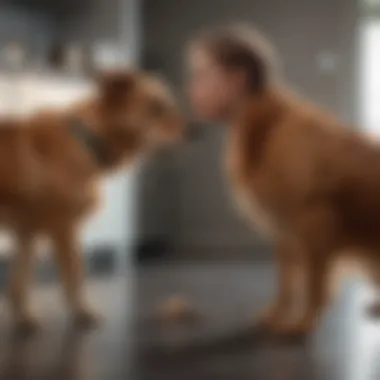Understanding Canine Behavior: Why Dogs Drag Their Butts


Intro
Dogs exhibit a variety of behaviors that can puzzle their owners. One such behavior is butt-dragging, often seen as amusing or concerning. However, this action may signal underlying issues that pet owners must understand. This article seeks to explain why dogs drag their butts on the floor, focusing on medical conditions, basic instincts, and behavioral factors. Potential reasons for such actions can range from health problems to simple itchiness. Before assuming any attitude, it is crucial to consider several factors that may impact their dramatic actions.
Pet Care Essentials
Understanding your dog’s habits requires knowledge about their everyday health and care needs. Here are a few primary areas to keep in mind:
Daily Nutrition Requirements
Feeding dogs well is paramount. Proper nutrition supports overall health and prevents conditions that could lead to habits like butt-dragging. Focus on high-quality dog food depending on their age, weight, and activity level. Regularly consult with a veterinarian to make sure your dog’s diet remains optimal.
Exercise and Playtime
Regular exercise is crucial. A well-exercised dog is less inclined to adopt odd behaviors that stem from boredome or anxiety. Participate in daily walks or engaging play sessions. Activities can importantly affect your dog's mood and behavior balance, fostering healthier habits.
Grooming Tips
Maintaining appropriate grooming is not just for looks. Proper grooming can reduce skin irritations that often contribute to behaviors like butt-dragging. Ensure regular bathing, brushing, and check for any signs of texture changes or abnormalities in your dog’s fur or skin.
Health and Wellness Check-ins
Routine veterinary visits cannot be overstated. Regular check-ins allow early identification of any potential issues, including allergies, skin infections, or other medical concerns. It's wise to observe any behavioral changes leading up to these visits. Monitoring changes provides clear data for your vet.
Behavior & Training
Understanding behaviors that do not conform to a dog's general character requires insight. Here’s what to pay attention to:
Understanding Your Pet's Body Language
Communication can be subtle, involving every little gesture. Observe leg movements, tail positions, and ear states to gain clues about their feelings. Such nuances indicate if your dog feels a state of unease or discomfort.
Basic Training Techniques
Training fosters positive behavior. Basic commands like sit, stay, and come direct energy positively. Reinforce good behavior through rewards, reinforcing the desire to abandon behaviors sometimes deemed troubling.
Behavioral Concerns & Solutions
When behaviors seem excessive or out of character, explore potential triggers, environmental changes, or stress levels. Using calmness and positivity can redirect behavior forcefully but gently.
Socialization Tips
Pack behavior is natural. Initiating socialization with other dogs and people builds confidence. It can decrease tendencies toward troubling self-comporal behaviors like butt dragging. Shield particularly sensitive dogs from interacting with aggressive personalities in the park most importantly.
Pet Health Issues
Health problems heavily influence behaviors. Awareness here is essential:
Recognizing Signs of Illness
Look at your dog closely. Common signals include altered eating habits, vomiting, or visible discomfort while sitting or lying down. Don’t ignore any signs, regardless of how insignificant they may seem. They could point towards a more significant issue.
Preventative Care Measures
Regular vaccines and parasite checks are crucial. Keeping healthy is the greatest way tp avoid illness; conducting health-forward plans might even save money in the long run, giving both security and health.
Common Ailments and Treatments


Various conditions can lead to butt-dragging include allergies or anal gland impaction. Appreciate the issues present by educating. Each represents an easy-to-miss signal a dog tries convey its dyscomfort. Contact a veterinarian when you suspect underlying issues to allow for necessary, immediate holistic targeted approach based on proper knowledge.
Emergency Preparedness
Preparedness crucial for uncertain situations concerning pets like car accident’s fears or quick health declines. Building a pet CPR knowledge foundation keeps detailed health information close, ensuring better decisions in emergencies.
Preamble to Canine Behavior
Understanding canine behavior is essential for any dog owner. Dogs are complex creatures, and their actions can speak volumes about their physical and mental well-being. In this section, we explore the intricate world of dog behavior, focusing on specific elements, benefits, and useful considerations related to their actions.
Defining Normal Dog Behavior
Normal dog behavior encompasses a wide range of actions and reactions, reflecting a dog's health, environment, and upbringing. Recognizing what constitutes normal behavior helps owners distinguish between harmless quirks and concerning symptoms.
Some signs of normal behavior include:
- Playfulness: Engaging in playtime with toys or other dogs.
- Exploration: Sniffing and investigating their environment.
- Social Interaction: Seeking companionship from both humans and fellow animals.
Understanding these behaviors can aid in interpreting a dog’s needs, signaling when they are happy, stressed, or anxious.
Common Canine Habits
Dogs exhibit a variety of habits that are largely instinctual. These skills may vary between breeds, but looking across the canine kingdom, some habits present themselves universally. Appreciating these behaviors can enrich our interactions with these pets.
Typical habits include:
- Barking: A natural form of communication, barking may serve varied purposes like announcing a visitor or expressing enthusiasm.
- Chewing: Dogs often chew to keep their teeth healthy, relieve anxiety, or explore their surroundings.
- Digging: Rooted in an instinct inherited from ancestors, digging can be a sign of seeking comfort or a means of exploring their territory.
It's crucial to approach these habits with knowledge and understanding. Changes in canine behaviors can often be indicative of underlying health issues or related stressors.
Proper education about canine behavior lays the foundation for better insights into actions that may initially seem puzzling, such as butt dragging. This topic will delve into the many elements that contribute to such behavior in dogs, providing valuable information for pet owners.
Physical Reasons for Butt Dragging
Understanding the physical reasons for butt dragging can provide crucial insights for pet owners. Many dogs drag their rear ends for various medical reasons that require attention. Recognizing the causes early can lead to timely interventions, which benefit a dog’s health and well-being. Not addressing the physical issues may lead to severe discomfort or worsening health problems in the future.
Anal Gland Issues
Understanding Anal Gland Function
The anal glands, also called anal sacs, are located on either side of a dog’s rectum. These glands secrete a fluid that serves various purposes, including marking territory. When a dog defecates, the pressure from the stool helps expel this fluid, which is crucial for natural behavior communication among dogs. Anal glands can, however, become problematic. Their malfunctioning can result in discomfort or even pain for the dog. An understanding of anal gland function enriches the foundation of canine behavior, helping owners to connect specific behaviors with potential health concerns.
Symptoms of Impacted Glands
When anal glands become impacted, the symptoms can be quite noticeable. Dogs may show signs of distress such as licking their rear ends excessively, experiencing pain while sleeping, or even whining and showing signs of irritation. Some dogs may rely on carpet or flooring surfaces to ease their discomfort, leading to the common behavior of butt dragging. Increased awareness of these symptoms can aid in addressing issues early, allowing for better management of a dog's health. Informing pet owners about the signs of impacted anal glands offers them a route to prevent more complex health issues from developing.
Skin Irritation and Allergies
Identifying Symptoms of Skin Conditions
Skin irritation can result in extreme discomfort and disturbing behaviors in dogs. Various conditions, ranging from localized infections to allergies, can make a dog dragging its behind. Recognizing when a dog has skin irritation involves looking for visible signs like redness, swelling, or even flaky skin around their hind section. These indicators often coincide with itching or scratching. Understanding how to identify skin issues educates owners on prompt responses, which can ultimately maintain their dog's quality of life.
Common Allergens Affecting Dogs
Many dogs face allergies due to seasonal changes, certain foods, or environmental substances like pollen or chemicals. Allergens can contribute to inflammation, result in excessive itching, and lead to butt dragging as a response. Knowing the common allergens that afflict dogs is valuable for pet owners. It also aids owners in altering their dogs’ environments and nutrition to minimize adverse effects. Being equipped with this knowledge also helps facilitate informed discussions with veterinarians about effective treatments.
Parasites
Common Types of Worms


Various types of worms, such as roundworms, tapeworms, and hookworms, can lead to a problematic situation that results in butt dragging. Dogs may drag their behinds due to irritation caused by these parasites irritating the intestinal and anal areas. The knowledge of these worms helps in recognizing a potential health threat to dogs. Addressing issues related to parasitic infections timely is vital to proper dog care. Without understanding these threats, dog owners risk their pet’s overall health and comfort.
Signs of a Parasite Infestation
Recognizing a parasite infestation early can make a significant difference in treatment success. Common signs include weight loss, poor coat condition, vomiting, or diarrhea. Dogs might also show signs of discomfort, reflected in behavior like dragging their rear ends across the floor. Educating dog owners about the distinct signs of a parasite infestation can enable them to take preventive or corrective actions, ensuring swift and effective treatment for their pets. Quick recognition can save dogs from extended suffering.
Behavioral Reasons for Butt Dragging
Understanding the underlying reasons why dogs may drag their butts on the floor is crucial in assuring both the animal's well-being and addressing pet owners’ concerns. Behavioral reasons are varied and can stem from instinctual actions, environmental stressors, or an outcome of seeking attention. Recognizing these influences is key for responsible dog ownership. Additional insights into canine behavior help to create effective management strategies for pets, leading to a healthier relationship between dogs and their human companions.
Instinctual Behavior
Dogs exhibit instinctual behaviors that have been ingrained over centuries. Some of these behaviors relate to how dogs interact with their surroundings and other animals. Butt dragging might seem odd but can be tied to instinctual actions motivated by specific drives. This behavior may involve marking territory and signaling health status to other canines, showing the natural inclination to communicate through scent and grooming processes. A fundamental understanding of instinctual interactions enables pet owners to appreciate their dog’s various functionalities, assisting in addressing behavioral issues effectively.
Stress and Anxiety
Behavioral patterns such as butt dragging may also reflect emotional states in dogs, particularly stress or anxiety. Stress manifests itself differently in dogs and recognizing the triggers of such distress is vital.
Identifying Triggers of Canine Stress
Identifying the influences that contribute to a dog’s stress is essential for effective management. Triggers can include changes in environment, interactions with other animals, or substantial alterations in household routines. Monitoring your dog's reactions in various situations sharpens awareness. This tracking can help owners pinpoint circumstances that disturb their pets and address these environments proactively.
Attention to these stressors can profoundly affect a dog's emotional landscape. Owners can tailor responses and create spaces for reassurance, which often leads to improved well-being.
Symptoms of Anxiety in Dogs
Understanding the symptoms of anxiety in dogs also enhances our comprehension of behavioral phenomena like butt dragging. Relationships between behaviors, such as obsessive licking or pacing, provide context when analyzing behavioral health. Symptoms of anxiety require a discerning eye, and early identification can guide relevant interventions. Addressing such symptoms efficiently arises from their nuanced expression, helping owners determine the likelihood of related stress.
Awareness of these indicators sharpens preparedness when transitions occur, proving beneficial throughout a dog's life. Prompt actions may influence long-term behavioral stability, contributing to a more harmonious pet-owner dynamic.
Attention-Seeking Behavior
The act of dragging butts may also resonate with attention-seeking tendencies in dogs. Pets often develop behaviors that capture their owners' focus, regardless if the attention is positive or negative. Dogs might revert to these tactics when they sense a decline in engagement from their owners. Understanding this behavioral strategy aids in deciphering dogs’ emotional needs and fosters active communication structures within pet-human relationships. Being aware and practicing consistent attention management can markedly change this behavior, supporting more effective interactions.
Assessing the Severity of Butt Dragging
Assessing the severity of butt dragging is crucial for dog owners. It helps in understanding when it's a benign habit or a signal of deeper health issues. Not all instances necessitate concern, but some situations indeed do. Determining what level of urgency to attribute to this behavior often comes down to both the duration and frequency of the action, as well as any accompanying health signs.
Duration and Frequency
Duration and frequency play significant roles in assessing canine butt dragging. A dog that occasionally drags its rear end after a long play session may not warrant immediate attention. However, frequent dragging can attract concern. It’s useful to record how often your dog showcases this behavior and how long each episode lasts. For instance, if it’s a daily occurrence, you might need to consult with a veterinarian. Short-term instances can often relate to simple irritations, while more persistent actions could signal health issues such as impacted anal glands or other underlying problems. When noticing butt dragging, keep track of how long the dog continues this activity. A casual note of days and times may provide vital clues for your vet visit.
Additional Symptoms to Monitor
While butt dragging can initially seem like a harmless act, it’s essential to evaluate any additional symptoms. Monitoring other behaviors will give a fuller understanding of your dog’s health status. Look out for the following:
- Licking Habits: Frequent licking around the tail area can point to irritation or allergies.
- Behavior Changes: Changes in appetite, mood, or playfulness could indicate discomfort.
- Swelling: Noticeable swelling around the anal region should not be ignored.
- Foul Odor: Any unusual smells can imply an infection or anal gland issue.
- Diarrhea or Constipation: Changes in stool can affect your dog's comfort and their normal behaviors.
- Scratching: If your dog is exhibiting this alongside dragging, it could signal skin issues.
Identifying and recording these additional symptoms can clarify the situation for both the pet owner and the veterinarian. Every bit of detail can contribute to an accurate diagnosis and subsequent treatment plan.
Keep a log of your dog's butt dragging events and any accompanying behaviors. This will help your veterinarian make an informed assessment.
In summary, distinguishing normal from concerning butt dragging largely relies upon evaluating frequency, duration, and observing for additional symptoms.
When to Seek Veterinary Assistance
In the realm of pet care, identifying when your dog needs veterinary assistance is crucial. Dogs often engage in behaviors that can pose alarming questions to owners. One particular behavior, butt dragging, may not always indicate a serious problem. However, understanding when this behavior necessitates a visit to the vet is vital for ensuring your dog’s health and well-being. Knowing what signs to look for can simplify this decision-making process and enhance your pet's quality of life.


Identifying Urgent Medical Needs
Recognizing urgent medical needs can prevent serious complications. If a dog is dragging its butt on the floor, consider monitoring additional signs. Symptoms such as crying, whining, or noticeable discomfort can suggest an underlying health issue that requires professional attention. Look for:
- Excessive licking around the anal area
- Foul smells equivalent to rancid fish
- Swelling or redness in the anal region
It’s important to trust your instincts. If your dog starts to exhibit any of these symptoms, seek immediate assistance from a veterinarian. Ignoring these signs might allow minor issues to escalate into more severe health concerns. Additionally, keep aware of your dog's overall behavior and its live quality, especially if accompanied with mood changes or lethargy.
Scheduled Vet Visits for Monitoring
Routine veterinary check-ups can do wonders for identifying potential problems. Constistent monitoring can lead to early detection of health issues. Schedule vet visits if you observe persistent butt dragging. An experienced veterinarian can perform necessary examinations and determine any need for treatment or interventions. Benefits of these visits include:
- Thorough examinations of your dog’s anal glands
- Assessment for skin conditions, allergies, or parasites
- Expert opinions on behavioral management if needed
Engaging in regular veterinary consultations can foster a proactive approach to your dog's health care. Dedicate time every six months or as advised to ensure your pet remains in good health. This allows collaboration between you and the veterinary professional, ultimately leading to better insights into behavior and preventive strategies for your dog's well-being.
“Recognizing changes in behavior, including butt dragging, can be key indicators in maintaining a dog’s health.”
Preventive Care for Dogs
Preventive care is a critical aspect of responsible pet ownership. It lays the foundation for a healthy and happy life for dogs. Regular preventive measures can significantly reduce the risks of future health issues, including the behaviors related to butt dragging. Being proactive is more useful than waiting until a problem arises.
Regular Grooming and Care Practices
Regular grooming serves multiple purposes. It helps to maintain a dog's coat, removes tangles, and keeps their skin healthy. This practice helps in identifying any skin irritations or infections early. Grooming tools like brushes and combs are essential to remove dead hair and dirt, preventing any discomfort that could lead to unwanted behaviors like butt dragging.
Some key aspects of regular grooming include:
- Bathing: Cleaning your dog regularly helps prevent skin issues. Use a mild dog shampoo to avoid irritation.
- Brushing: This can reduce shedding and help detect skin problems before they escalate.
- Nail Trimming: Keeping nails short can prevent walk-related discomfort, thus reducing stress or anxiety that may cause butt dragging.
- Ear Cleaning: Keeping a dog’s ears clean helps reduce the mixture of bacteria that can sometimes irritate the skin around the bottom area.
Engaging in these practices can diminish the likelihood of skinrelated issues and enhance your dog’s comfort overall. Regular grooming isn't solely about aesthetics; it plays a fundamental role in physical health, which can, in turn, mitigate changes in behavior.
Diet and Nutrition Considerations
Good nutrition is vital for maintaining a dog's overall wellbeing. A balanced diet can strengthen any dog's immune system, keeping parasites and other health issues at bay. A poor diet can lead to obesity, which can cause stress on joints and create discomfort, possibly leading to behaviors like butt dragging.
When selecting food for your dog, consider:
- High-Quality Ingredients: Choose dog food with meat as the primary ingredient, free from unnecessary fillers.
- Balanced Nutrients: Ensure their diet includes proper proportions of proteins, fats, vitamins, and minerals.
- Consult a Vet: Regular veterinary consultations can help you understand what is best for your dog’s age, breed, and health. A vet's advice may include incorporating grain-free or specific free-form diets for those with sensitivities.
Nutrition-related practices:
- Regular Feeding Schedule: Maintain consistent mealtimes to 0promote a steady digestive process.
- Healthy Treats: Choosing healthy dog treats as part of training or reward can promote pets’ wellbeing, aiding in overall behavior riceyness.
Ultimately, understanding canine nutrition can foster healthier life choices for your pets, benefiting both your dog's physical health and behavioral habits widely.
Ending
Understanding why dogs drag their butts on the floor involves delving into multiple facets of canine behavior. This article provides insights that encompass physical, medical, and instinctual reasons for this action. Recognizing the importance of context is essential for a dog owner. Knowing when butt dragging is normal playful behavior and when it indicates a health concern plays a valuable role in both the owner's and dog's quality of life.
Summarizing Key Points
In summary, there are several key takeaways regarding dogs dragging their butts:
- Physical Health: Issues such as anal gland problems, infections, and skin irritations can lead to butt dragging. It is critical for owners to monitor these health indicators closely.
- Behavioral Aspects: Factors such as anxiety or the instinct to spread scent can also play a role in this behavior. A comprehensive understanding can help owners in addressing their pets' emotional needs effectively.
- Proactive Measures: Regular grooming, attention to diet, and psychological well-being are crucial.
"Being observant of each characteristic behavior in dogs allows empowered pet owners to take informed measures that may affect their dog's health in the long run."
Encouragement for Proactive Care
Pet owners should adopt a proactive approach in caring for their dogs. Here are several considerations that can enrich their experience:
- Regular Vet Visits: Establishing routine check-ups is vital for early detection of any potential health issues. Awareness of an irregularity can lead to timely priorities in treatment.
- Grooming Practices: Frequent grooming can identify skin issues such as allergies or irritations. Regular grooming decreases the likelihood of infections as well.
- Balanced Diet: Nutrition plays a significant role in overall health. Including omega fatty acids and avoiding allergens may improve skin conditions.
By tending to these aspects carefully, dog owners ensure not just the health of their pets, but a more harmonious living situation where behavioral oddities are meaningful rather than worrisome.







